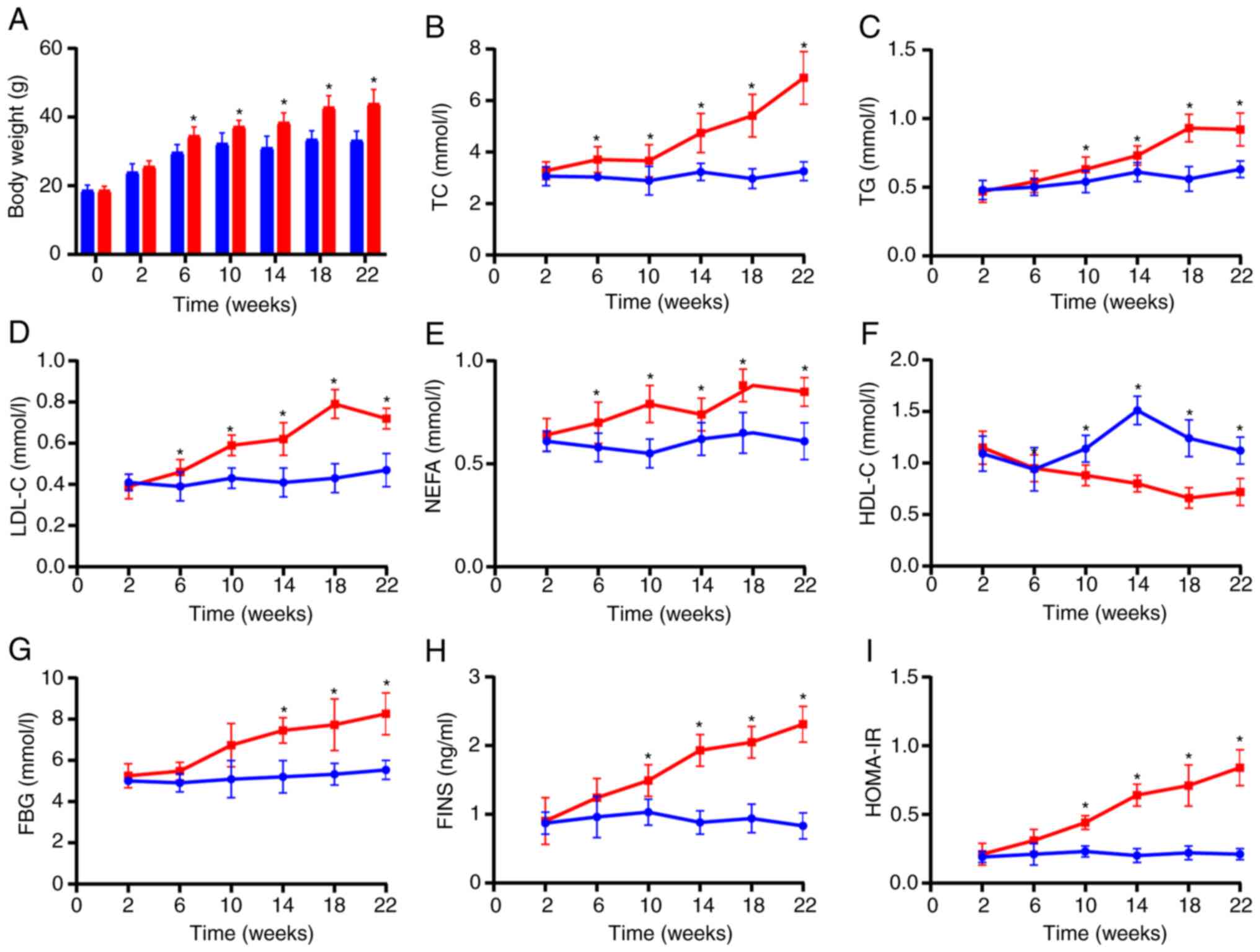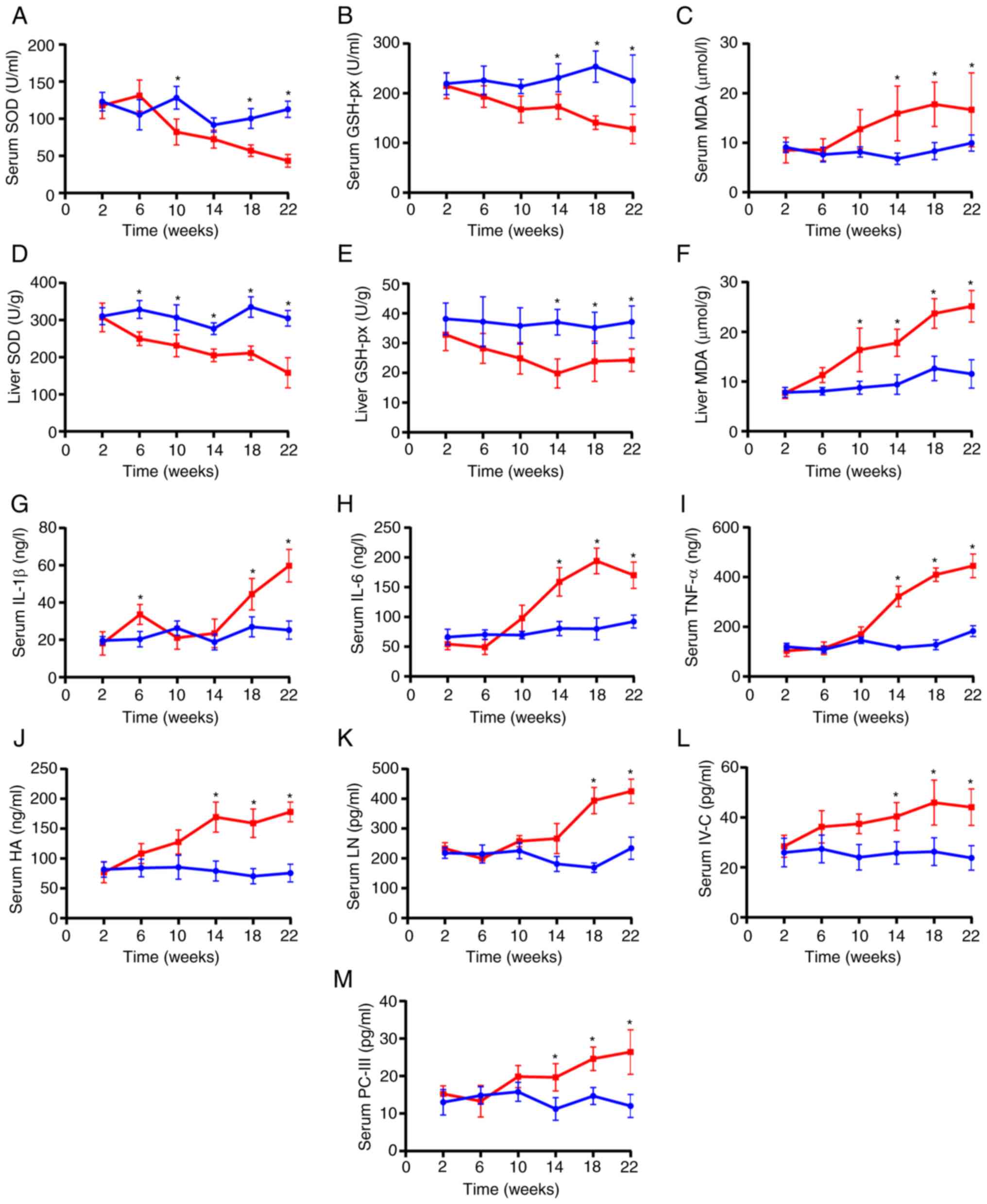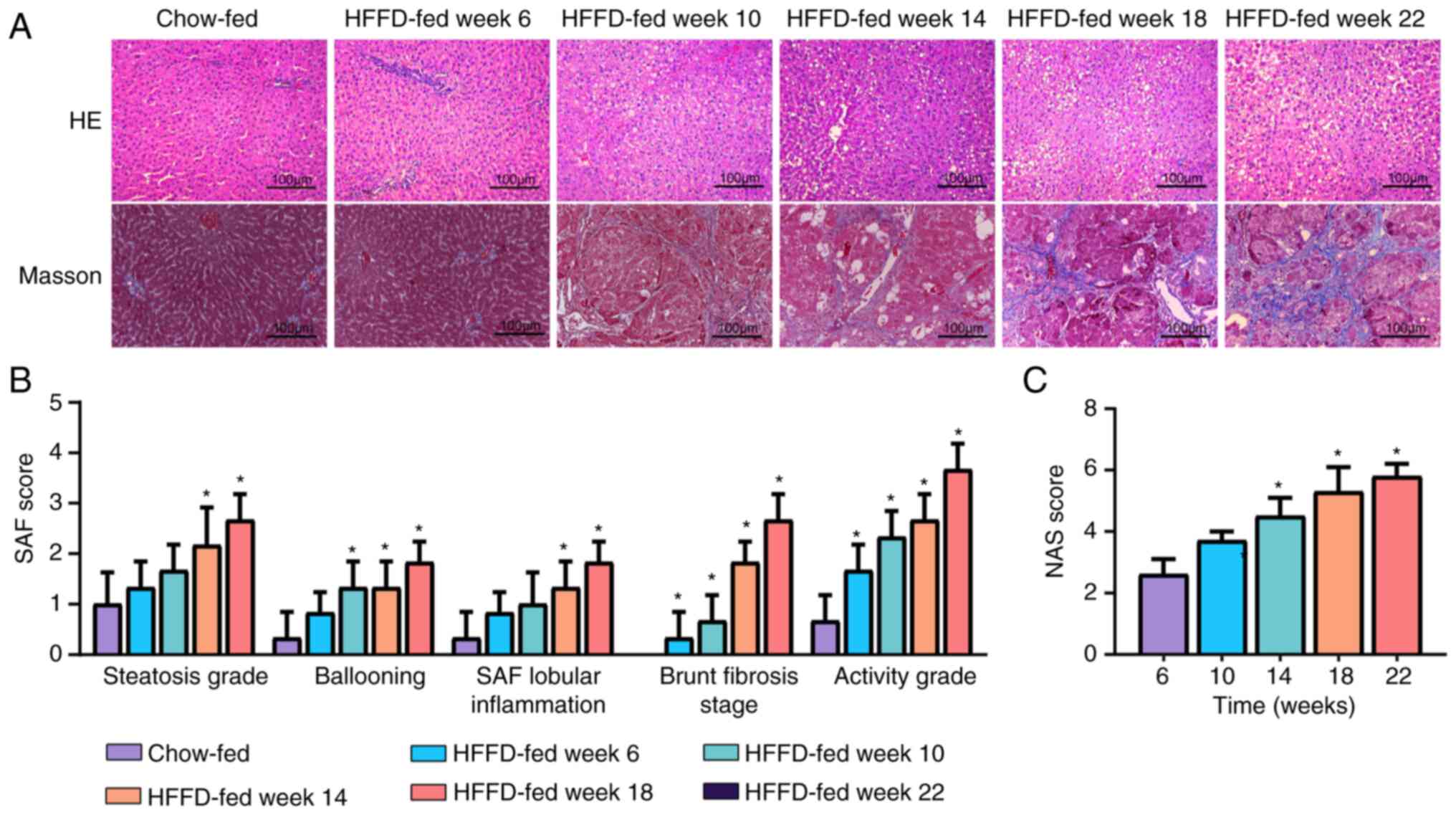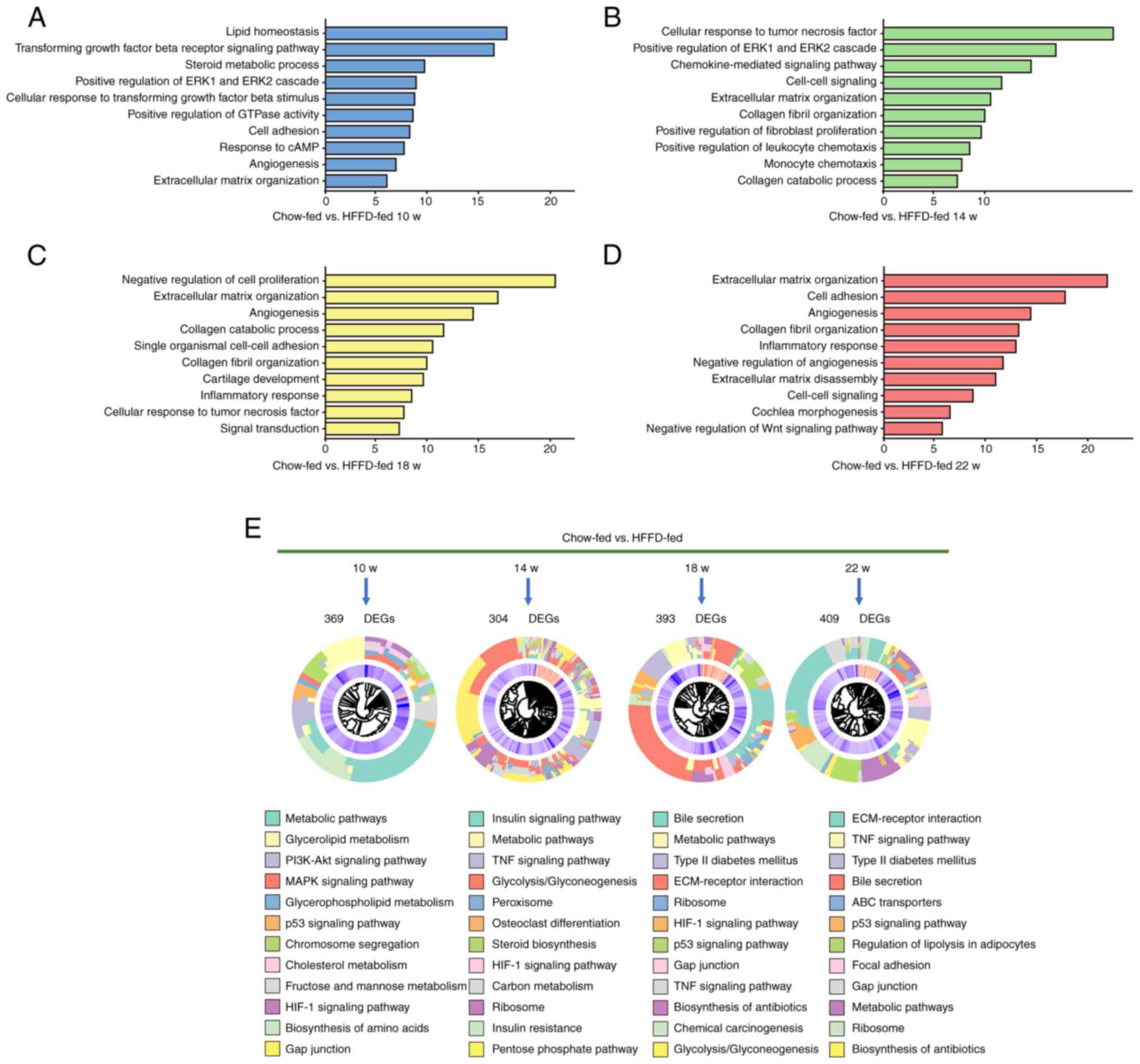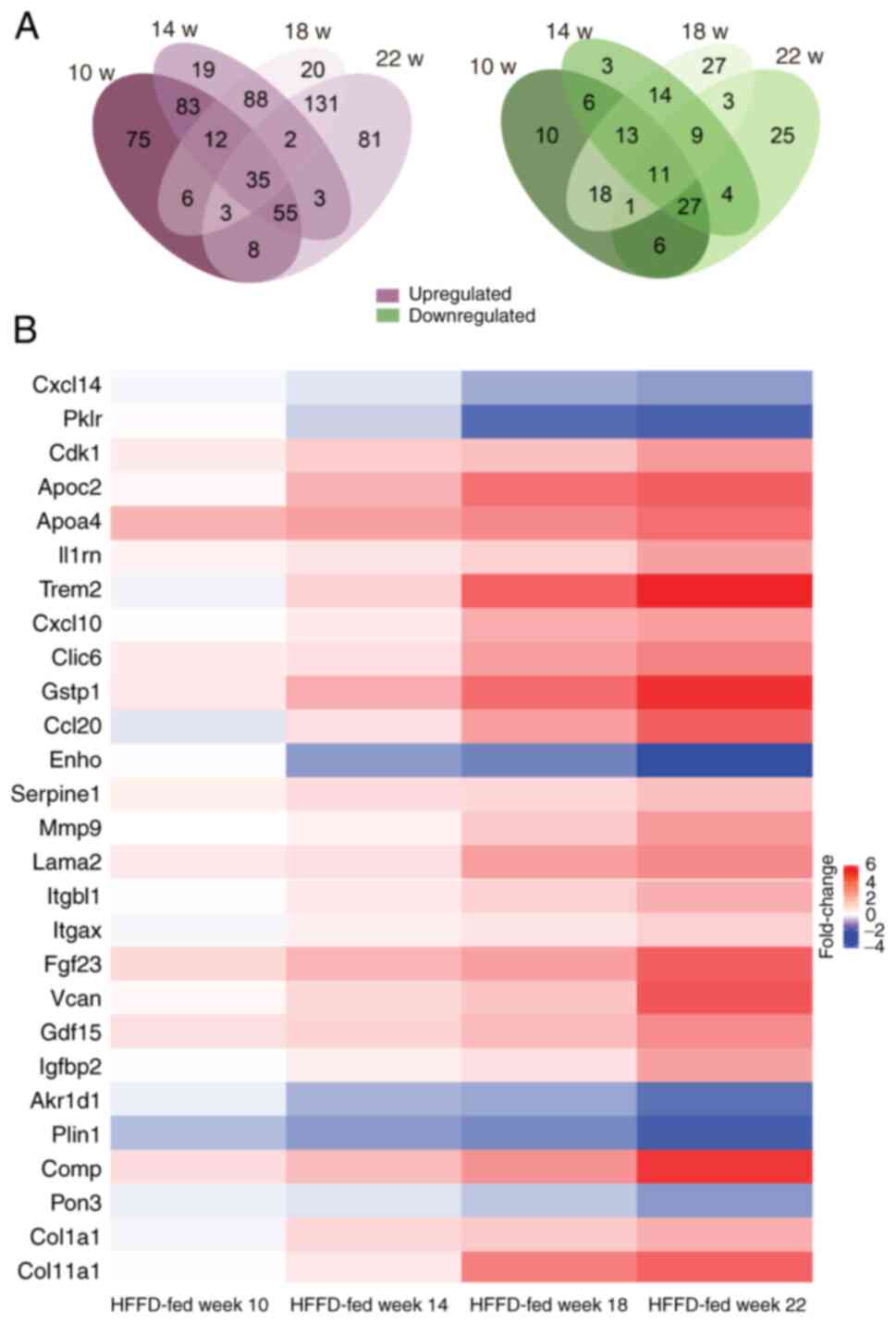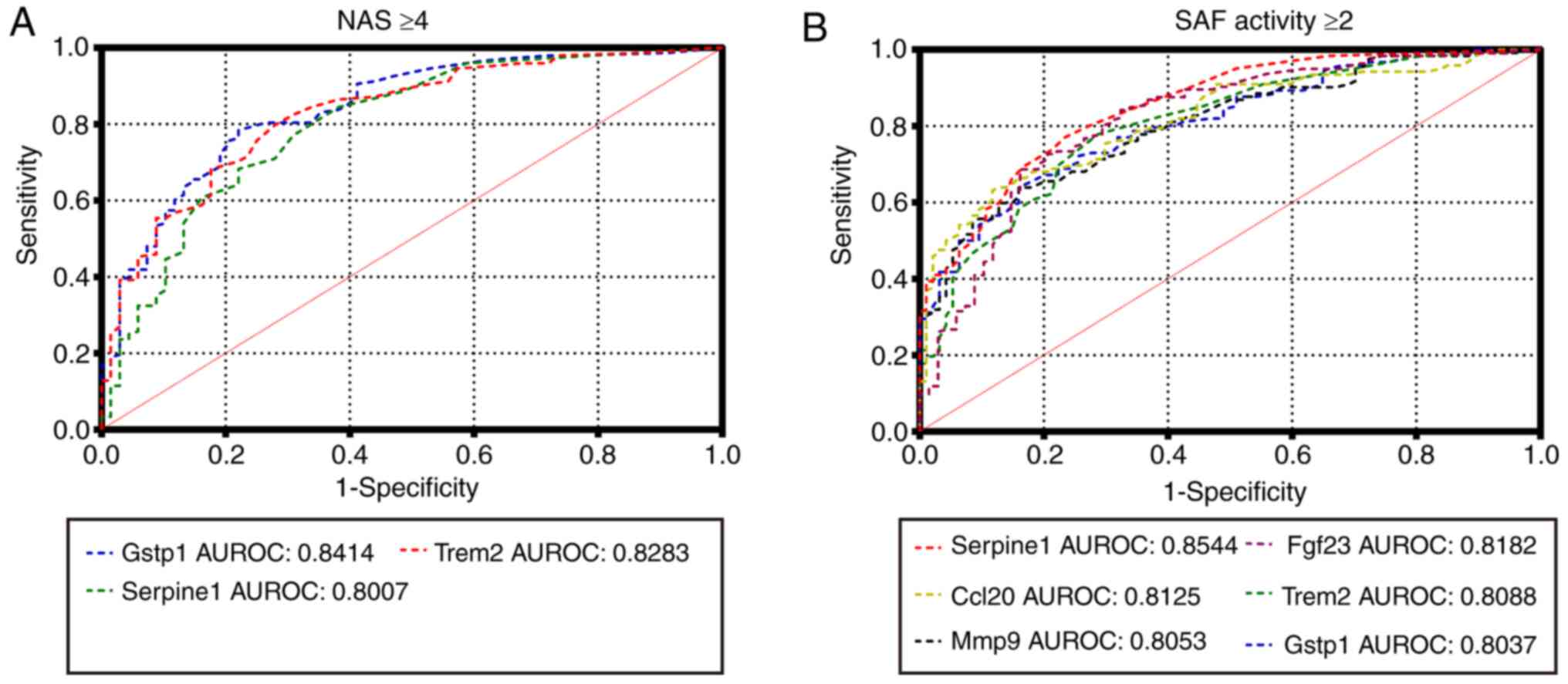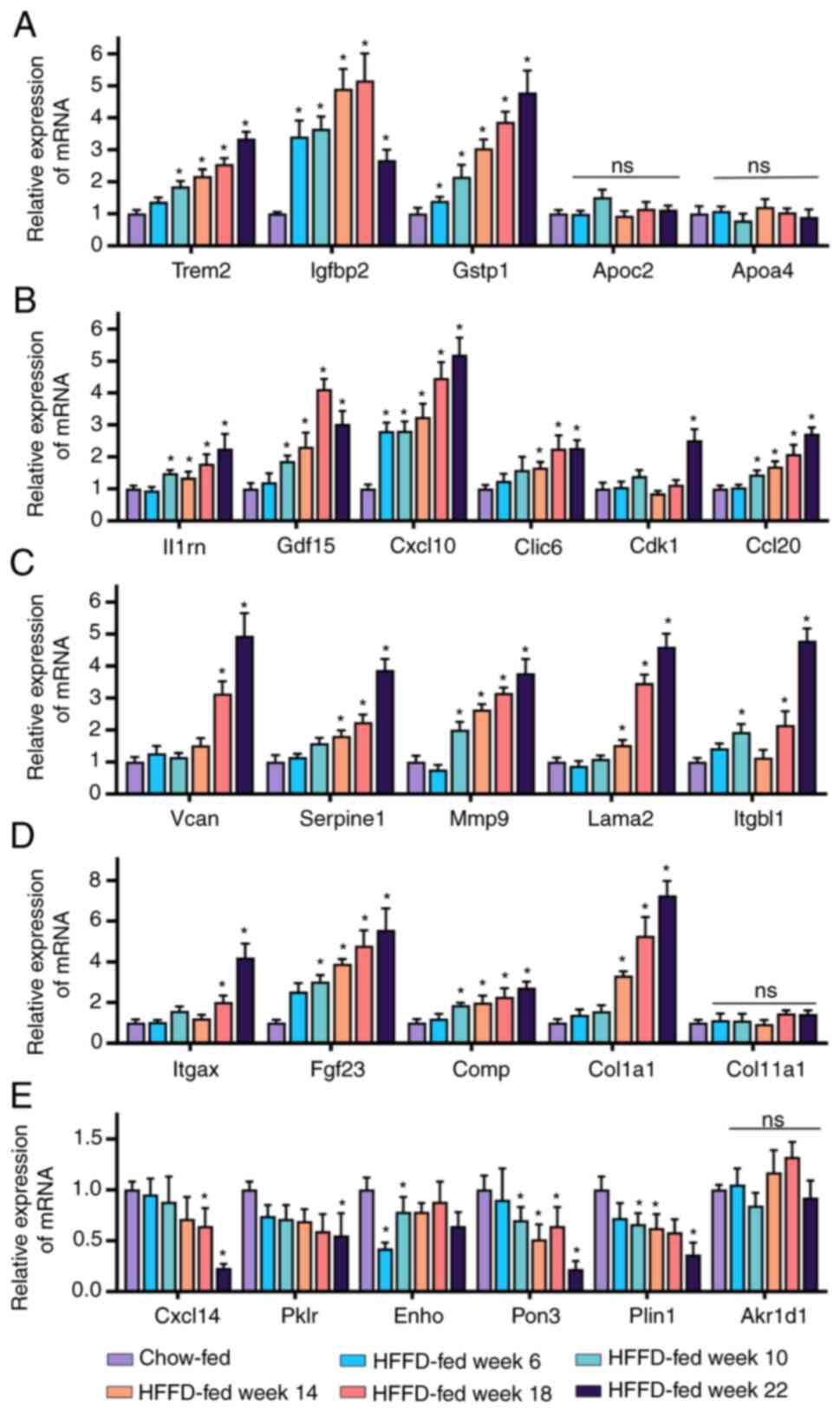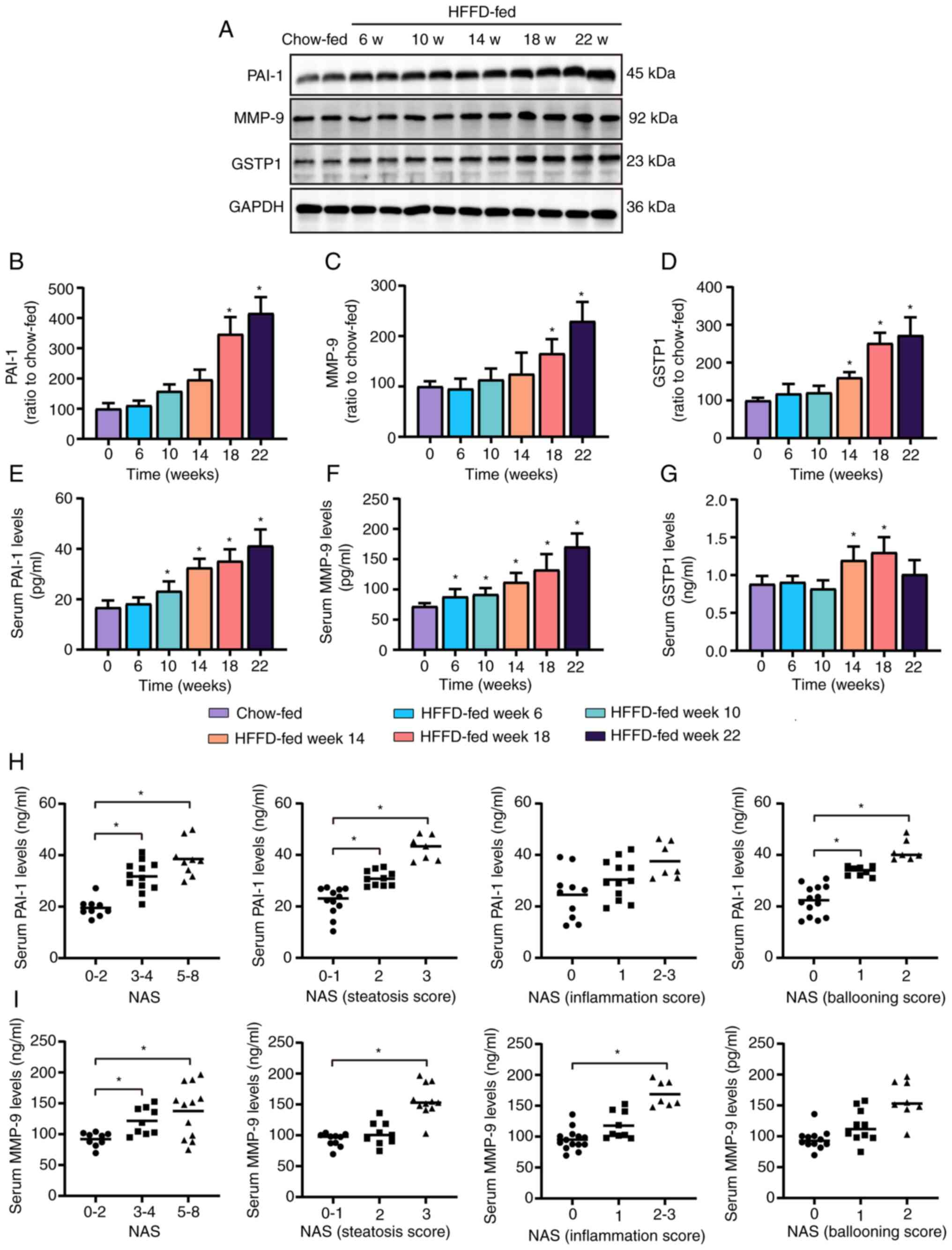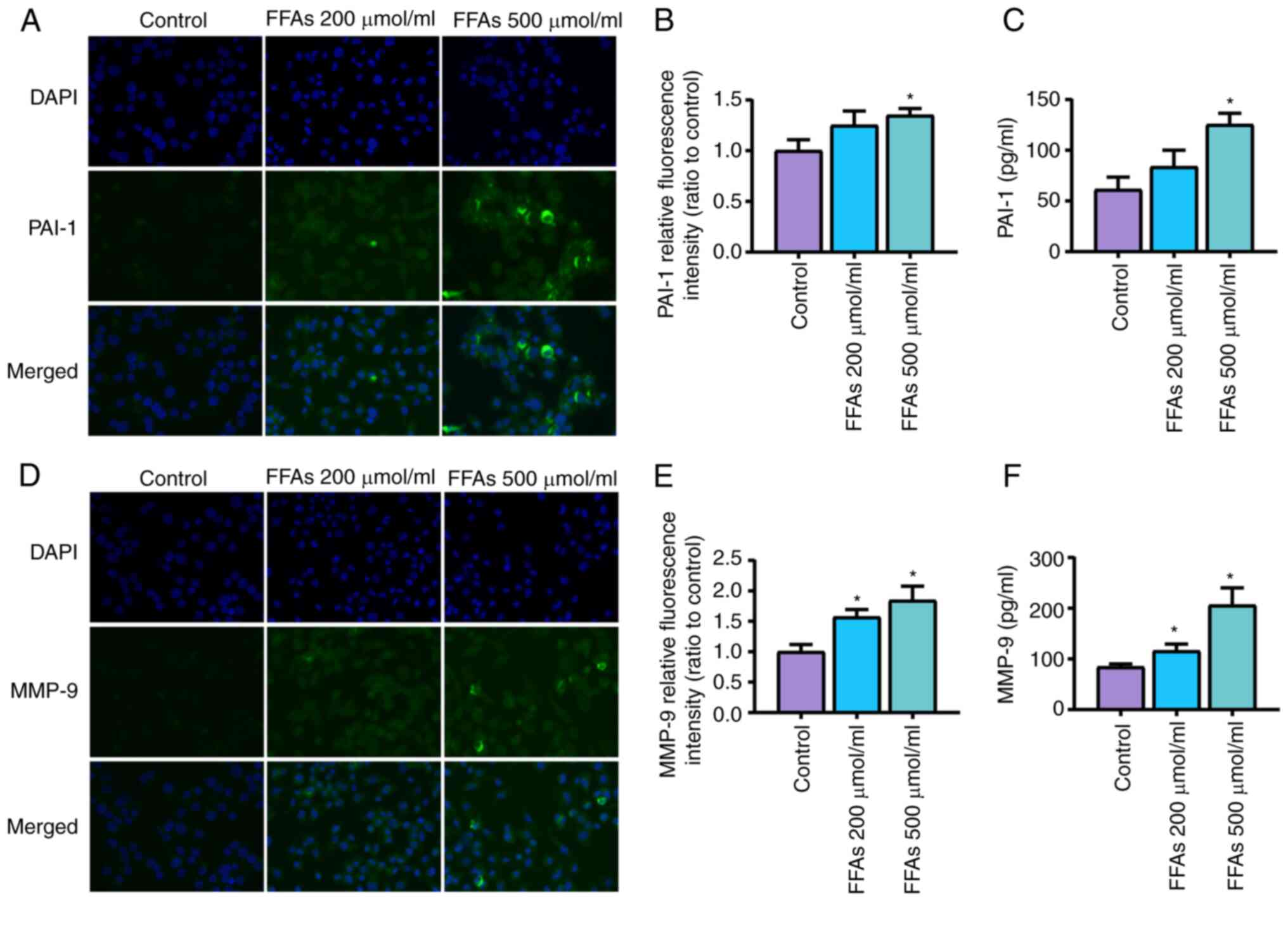|
1
|
Sheka AC, Adeyi O, Thompson J, Hameed B,
Crawford PA and Ikramuddin S: Nonalcoholic steatohepatitis: A
review. JAMA. 323:1175–1183. 2020. View Article : Google Scholar : PubMed/NCBI
|
|
2
|
Llovet JM, Willoughby CE, Singal AG,
Greten TF, Heikenwälder M, El-Serag HB, Finn RS and Friedman SL:
Nonalcoholic steatohepatitis-related hepatocellular carcinoma:
Pathogenesis and treatment. Nat Rev Gastroenterol Hepatol.
20:487–503. 2023. View Article : Google Scholar : PubMed/NCBI
|
|
3
|
Younossi ZM, Koenig AB, Abdelatif D, Fazel
Y, Henry L and Wymer M: Global epidemiology of nonalcoholic fatty
liver disease-meta-analytic assessment of prevalence, incidence,
and outcomes. Hepatology. 64:73–84. 2016. View Article : Google Scholar : PubMed/NCBI
|
|
4
|
Younossi Z, Anstee QM, Marietti M, Hardy
T, Henry L, Eslam M, George J and Bugianesi E: Global burden of
NAFLD and NASH: Trends, predictions, risk factors and prevention.
Nat Rev Gastroenterol Hepatol. 15:11–20. 2018. View Article : Google Scholar : PubMed/NCBI
|
|
5
|
Ye Q, Zou B, Yeo YH, Li J, Huang DQ, Wu Y,
Yang H, Liu C, Kam LY, Tan XXE, et al: Global prevalence,
incidence, and outcomes of non-obese or lean non-alcoholic fatty
liver disease: A systematic review and meta-analysis. Lancet
Gastroenterol Hepatol. 5:739–752. 2020. View Article : Google Scholar : PubMed/NCBI
|
|
6
|
Farrell GC and Larter CZ: Nonalcoholic
fatty liver disease: From steatosis to cirrhosis. Hepatology. 43((2
Suppl 1)): S99–S112. 2006. View Article : Google Scholar : PubMed/NCBI
|
|
7
|
Younossi ZM: Non-alcoholic fatty liver
disease-A global public health perspective. J Hepatol. 70:531–544.
2019. View Article : Google Scholar : PubMed/NCBI
|
|
8
|
Angulo P, Keach JC, Batts KP and Lindor
KD: Independent predictors of liver fibrosis in patients with
nonalcoholic steatohepatitis. Hepatology. 30:1356–1362. 1999.
View Article : Google Scholar : PubMed/NCBI
|
|
9
|
Tarantino G, Crocetto F, Di Vito C, Creta
M, Martino R, Pandolfo SD, Pesce S, Napolitano L, Capone D and
Imbimbo C: Association of NAFLD and insulin resistance with non
metastatic bladder cancer patients: A cross-sectional retrospective
study. J Clin Med. 10:3462021. View Article : Google Scholar : PubMed/NCBI
|
|
10
|
Cotter TG and Rinella M: Nonalcoholic
fatty liver disease 2020: The state of the disease.
Gastroenterology. 158:1851–1864. 2020. View Article : Google Scholar : PubMed/NCBI
|
|
11
|
Le MH, Le DM, Baez TC, Wu Y, Ito T, Lee
EY, Lee K, Stave CD, Henry L, Barnett SD, et al: Global incidence
of non-alcoholic fatty liver disease: A systematic review and
meta-analysis of 63 studies and 1,201,807 persons. J Hepatol.
79:287–295. 2023. View Article : Google Scholar : PubMed/NCBI
|
|
12
|
Bedossa P, Poitou C, Veyrie N, Bouillot
JL, Basdevant A, Paradis V, Tordjman J and Clement K:
Histopathological algorithm and scoring system for evaluation of
liver lesions in morbidly obese patients. Hepatology. 56:1751–1759.
2012. View Article : Google Scholar : PubMed/NCBI
|
|
13
|
Kleiner DE, Brunt EM, Van Natta M, Behling
C, Contos MJ, Cummings OW, Ferrell LD, Liu YC, Torbenson MS,
Unalp-Arida A, et al: Design and validation of a histological
scoring system for nonalcoholic fatty liver disease. Hepatology.
41:1313–1321. 2005. View Article : Google Scholar : PubMed/NCBI
|
|
14
|
Taylor RS, Taylor RJ, Bayliss S, Hagström
H, Nasr P, Schattenberg JM, Ishigami M, Toyoda H, Wai-Sun Wong V,
Peleg N, et al: Association between fibrosis stage and outcomes of
patients with nonalcoholic fatty liver disease: A systematic review
and meta-analysis. Gastroenterology. 158:1611–1625.e12. 2020.
View Article : Google Scholar : PubMed/NCBI
|
|
15
|
Makri E, Goulas A and Polyzos SA:
Epidemiology, pathogenesis, diagnosis and emerging treatment of
nonalcoholic fatty liver disease. Arch Med Res. 52:25–37. 2021.
View Article : Google Scholar : PubMed/NCBI
|
|
16
|
Anstee QM, Reeves HL, Kotsiliti E, Govaere
O and Heikenwalder M: From NASH to HCC: Current concepts and future
challenges. Nat Rev Gastroenterol Hepatol. 16:411–428. 2019.
View Article : Google Scholar : PubMed/NCBI
|
|
17
|
Haas JT, Vonghia L, Mogilenko DA,
Verrijken A, Molendi-Coste O, Fleury S, Deprince A, Nikitin A,
Woitrain E, Ducrocq-Geoffroy L, et al: Transcriptional network
analysis implicates altered hepatic immune function in NASH
development and resolution. Nat Metab. 1:604–614. 2019. View Article : Google Scholar : PubMed/NCBI
|
|
18
|
Bedossa P: Diagnosis of non-alcoholic
fatty liver disease/non-alcoholic steatohepatitis: Why liver biopsy
is essential. Liver Int. 38 (Suppl 1):S64–S66. 2018. View Article : Google Scholar
|
|
19
|
Ratziu V, Charlotte F, Heurtier A, Gombert
S, Giral P, Bruckert E, Grimaldi A, Capron F and Poynard T; LIDO
Study Group, : Sampling variability of liver biopsy in nonalcoholic
fatty liver disease. Gastroenterology. 128:1898–1906. 2005.
View Article : Google Scholar : PubMed/NCBI
|
|
20
|
Park CC, Nguyen P, Hernandez C,
Bettencourt R, Ramirez K, Fortney L, Hooker J, Sy E, Savides MT,
Alquiraish MH, et al: Magnetic resonance elastography vs transient
elastography in detection of fibrosis and noninvasive measurement
of steatosis in patients with biopsy-proven nonalcoholic fatty
liver disease. Gastroenterology. 152:598–607.e2. 2017. View Article : Google Scholar : PubMed/NCBI
|
|
21
|
Angulo P, Kleiner DE, Dam-Larsen S, Adams
LA, Bjornsson ES, Charatcharoenwitthaya P, Mills PR, Keach JC,
Lafferty HD, Stahler A, et al: Liver fibrosis, but no other
histologic features, is associated with long-term outcomes of
patients with nonalcoholic fatty liver disease. Gastroenterology.
149:389–397.e10. 2015. View Article : Google Scholar : PubMed/NCBI
|
|
22
|
Karlsen TH, Sheron N, Zelber-Sagi S,
Carrieri P, Dusheiko G, Bugianesi E, Pryke R, Hutchinson SJ, Sangro
B, Martin NK, et al: The EASL-lancet liver commission: Protecting
the next generation of Europeans against liver disease
complications and premature mortality. Lancet. 399:61–116. 2022.
View Article : Google Scholar : PubMed/NCBI
|
|
23
|
Angulo P, Hui JM, Marchesini G, Bugianesi
E, George J, Farrell GC, Enders F, Saksena S, Burt AD, Bida JP, et
al: The NAFLD fibrosis score: A noninvasive system that identifies
liver fibrosis in patients with NAFLD. Hepatology. 45:846–854.
2007. View Article : Google Scholar : PubMed/NCBI
|
|
24
|
Graupera I, Thiele M, Serra-Burriel M,
Caballeria L, Roulot D, Wong GL, Fabrellas N, Guha IN, Arslanow A,
Expósito C, et al: Low accuracy of FIB-4 and NAFLD fibrosis scores
for screening for liver fibrosis in the population. Clin
Gastroenterol Hepatol. 20:2567–2576.e6. 2022. View Article : Google Scholar : PubMed/NCBI
|
|
25
|
Kjaergaard M, Lindvig KP, Thorhauge KH,
Andersen P, Hansen JK, Kastrup N, Jensen JM, Hansen CD, Johansen S,
Israelsen M, et al: Using the ELF test, FIB-4 and NAFLD fibrosis
score to screen the population for liver disease. J Hepatol.
79:277–286. 2023. View Article : Google Scholar : PubMed/NCBI
|
|
26
|
Day JW and Rosenberg WM: The enhanced
liver fibrosis (ELF) test in diagnosis and management of liver
fibrosis. Br J Hosp Med (Lond). 79:694–699. 2018. View Article : Google Scholar : PubMed/NCBI
|
|
27
|
Bolarin DM and Azinge EC: Biochemical
markers, extracellular components in liver fibrosis and cirrhosis.
Nig Q J Hosp Med. 17:42–52. 2007. View Article : Google Scholar : PubMed/NCBI
|
|
28
|
Boyle M, Tiniakos D, Schattenberg JM,
Ratziu V, Bugianessi E, Petta S, Oliveira CP, Govaere O, Younes R,
McPherson S, et al: Performance of the PRO-C3 collagen neo-epitope
biomarker in non-alcoholic fatty liver disease. JHEP Rep.
1:188–198. 2019. View Article : Google Scholar : PubMed/NCBI
|
|
29
|
Wong VW, Adams LA, de Lédinghen V, Wong GL
and Sookoian S: Noninvasive biomarkers in NAFLD and NASH-current
progress and future promise. Nat Rev Gastroenterol Hepatol.
15:461–478. 2018. View Article : Google Scholar : PubMed/NCBI
|
|
30
|
Daniels SJ, Leeming DJ, Eslam M, Hashem
AM, Nielsen MJ, Krag A, Karsdal MA, Grove JI, Neil Guha I,
Kawaguchi T, et al: ADAPT: An algorithm incorporating PRO-C3
accurately identifies patients with NAFLD and advanced fibrosis.
Hepatology. 69:1075–1086. 2019. View Article : Google Scholar : PubMed/NCBI
|
|
31
|
Harrison SA, Ratziu V, Boursier J,
Francque S, Bedossa P, Majd Z, Cordonnier G, Sudrik FB, Darteil R,
Liebe R, et al: A blood-based biomarker panel (NIS4) for
non-invasive diagnosis of non-alcoholic steatohepatitis and liver
fibrosis: A prospective derivation and global validation study.
Lancet Gastroenterol Hepatol. 5:970–985. 2020. View Article : Google Scholar : PubMed/NCBI
|
|
32
|
Matteoni CA, Younossi ZM, Gramlich T,
Boparai N, Liu YC and McCullough AJ: Nonalcoholic fatty liver
disease: A spectrum of clinical and pathological severity.
Gastroenterology. 116:1413–1419. 1999. View Article : Google Scholar : PubMed/NCBI
|
|
33
|
Tatler AL: Recent advances in the
non-invasive assessment of fibrosis using biomarkers. Curr Opin
Pharmacol. 49:110–115. 2019. View Article : Google Scholar : PubMed/NCBI
|
|
34
|
Piazzolla VA and Mangia A: Noninvasive
diagnosis of NAFLD and NASH. Cells. 9:10052020. View Article : Google Scholar : PubMed/NCBI
|
|
35
|
Govaere O, Cockell S, Tiniakos D, Queen R,
Younes R, Vacca M, Alexander L, Ravaioli F, Palmer J, Petta S, et
al: Transcriptomic profiling across the nonalcoholic fatty liver
disease spectrum reveals gene signatures for steatohepatitis and
fibrosis. Sci Transl Med. 12:eaba44482020. View Article : Google Scholar : PubMed/NCBI
|
|
36
|
Castera L, Friedrich-Rust M and Loomba R:
Noninvasive assessment of liver disease in patients with
nonalcoholic fatty liver disease. Gastroenterology.
156:1264–1281.e4. 2019. View Article : Google Scholar : PubMed/NCBI
|
|
37
|
Vilar-Gomez E and Chalasani N:
Non-invasive assessment of non-alcoholic fatty liver disease:
Clinical prediction rules and blood-based biomarkers. J Hepatol.
68:305–315. 2018. View Article : Google Scholar : PubMed/NCBI
|
|
38
|
Hoang SA, Oseini A, Feaver RE, Cole BK,
Asgharpour A, Vincent R, Siddiqui M, Lawson MJ, Day NC, Taylor JM,
et al: Gene expression predicts histological severity and reveals
distinct molecular profiles of nonalcoholic fatty liver disease.
Sci Rep. 9:125412019. View Article : Google Scholar : PubMed/NCBI
|
|
39
|
Suppli MP, Rigbolt KTG, Veidal SS, Heebøll
S, Eriksen PL, Demant M, Bagger JI, Nielsen JC, Oró D, Thrane SW,
et al: Hepatic transcriptome signatures in patients with varying
degrees of nonalcoholic fatty liver disease compared with healthy
normal-weight individuals. Am J Physiol Gastrointest Liver Physiol.
316:G462–G472. 2019. View Article : Google Scholar : PubMed/NCBI
|
|
40
|
Loomba R and Sanyal AJ: The global NAFLD
epidemic. Nat Rev Gastroenterol Hepatol. 10:686–690. 2013.
View Article : Google Scholar : PubMed/NCBI
|
|
41
|
European Association for the Study of
Liver, . EASL clinical practical guidelines: Management of
alcoholic liver disease. J Hepatol. 57:399–420. 2012. View Article : Google Scholar : PubMed/NCBI
|
|
42
|
Negi CK, Babica P, Bajard L,
Bienertova-Vasku J and Tarantino G: Insights into the molecular
targets and emerging pharmacotherapeutic interventions for
nonalcoholic fatty liver disease. Metabolism. 126:1549252022.
View Article : Google Scholar : PubMed/NCBI
|
|
43
|
Abozaid YJ, Ayada I, van Kleef LA,
Vallerga CL, Pan Q, Brouwer WP, Ikram MA, Van Meurs J, de Knegt RJ
and Ghanbari M: Plasma proteomic signature of fatty liver disease:
The rotterdam study. Hepatology. 78:284–294. 2023. View Article : Google Scholar : PubMed/NCBI
|
|
44
|
Ratziu V, Francque S and Sanyal A:
Breakthroughs in therapies for NASH and remaining challenges. J
Hepatol. 76:1263–1278. 2022. View Article : Google Scholar : PubMed/NCBI
|
|
45
|
Ramanan SP, Mohamed MWF, Aung SS, Sange I
and Hamid P: Treatment of fatty liver disease: The present and the
future. Cureus. 13:e127132021.PubMed/NCBI
|
|
46
|
Fu Y, Zhou Y, Shen L, Li X, Zhang H, Cui
Y, Zhang K, Li W, Chen WD, Zhao S, et al: Diagnostic and
therapeutic strategies for non-alcoholic fatty liver disease. Front
Pharmacol. 13:9733662022. View Article : Google Scholar : PubMed/NCBI
|
|
47
|
Hosseini-Esfahani F, Bahadoran Z, Mirmiran
P, Hosseinpour-Niazi S, Hosseinpanah F and Azizi F: Dietary
fructose and risk of metabolic syndrome in adults: Tehran lipid and
glucose study. Nutr Metab (Lond). 8:502011. View Article : Google Scholar : PubMed/NCBI
|
|
48
|
Heikkinen S, Argmann CA, Champy MF and
Auwerx J: Evaluation of glucose homeostasis. Curr Protoc Mol Biol
Chapter. 29:Unit 29B.3. 2007.PubMed/NCBI
|
|
49
|
Love MI, Huber W and Anders S: Moderated
estimation of fold change and dispersion for RNA-seq data with
DESeq2. Genome Biol. 15:5502014. View Article : Google Scholar : PubMed/NCBI
|
|
50
|
Yu G, Wang LG, Han Y and He QY:
clusterProfiler: an R package for comparing biological themes among
gene clusters. OMICS. 16:284–287. 2012. View Article : Google Scholar : PubMed/NCBI
|
|
51
|
Livak KJ and Schmittgen TD: Analysis of
relative gene expression data using real-time quantitative PCR and
the 2(−Delta Delta C(T)) method. Methods. 25:402–408. 2001.
View Article : Google Scholar : PubMed/NCBI
|
|
52
|
McPherson S, Hardy T, Henderson E, Burt
AD, Day CP and Anstee QM: Evidence of NAFLD progression from
steatosis to fibrosing-steatohepatitis using paired biopsies:
Implications for prognosis and clinical management. J Hepatol.
62:1148–1155. 2015. View Article : Google Scholar : PubMed/NCBI
|
|
53
|
Huang DQ, Terrault NA, Tacke F, Gluud LL,
Arrese M, Bugianesi E and Loomba R: Global epidemiology of
cirrhosis-aetiology, trends and predictions. Nat Rev Gastroenterol
Hepatol. 20:388–398. 2023. View Article : Google Scholar : PubMed/NCBI
|
|
54
|
Tarantino G, Balsano C, Santini SJ,
Brienza G, Clemente I, Cosimini B and Sinatti G: It is high time
physicians thought of natural products for alleviating NAFLD. Is
there sufficient evidence to use them? Int J Mol Sci.
22:134242021.PubMed/NCBI
|
|
55
|
Santhekadur PK, Kumar DP and Sanyal AJ:
Preclinical models of non-alcoholic fatty liver disease. J Hepatol.
68:230–237. 2018. View Article : Google Scholar : PubMed/NCBI
|
|
56
|
Eng JM and Estall JL: Diet-induced models
of non-alcoholic fatty liver disease: Food for thought on sugar,
fat, and cholesterol. Cells. 10:18052021. View Article : Google Scholar : PubMed/NCBI
|
|
57
|
Rinella ME and Green RM: The
methionine-choline deficient dietary model of steatohepatitis does
not exhibit insulin resistance. J Hepatol. 40:47–51. 2004.
View Article : Google Scholar : PubMed/NCBI
|
|
58
|
Lau JKC, Zhang X and Yu J: Animal models
of non-alcoholic fatty liver disease: Current perspectives and
recent advances. J Pathol. 241:36–44. 2017. View Article : Google Scholar : PubMed/NCBI
|
|
59
|
Zhong F, Zhou X, Xu J and Gao L: Rodent
models of nonalcoholic fatty liver disease. Digestion. 101:522–535.
2020. View Article : Google Scholar : PubMed/NCBI
|
|
60
|
Lee JS, Jun DW, Kim EK, Jeon HJ, Nam HH
and Saeed WK: Histologic and metabolic derangement in high-fat,
high-fructose, and combination diet animal models.
ScientificWorldJournal. 2015:3063262015. View Article : Google Scholar : PubMed/NCBI
|
|
61
|
Chen Z, Tian R, She Z, Cai J and Li H:
Role of oxidative stress in the pathogenesis of nonalcoholic fatty
liver disease. Free Radic Biol Med. 152:116–141. 2020. View Article : Google Scholar : PubMed/NCBI
|
|
62
|
Sveinbjornsson G, Ulfarsson MO,
Thorolfsdottir RB, Jonsson BA, Einarsson E, Gunnlaugsson G,
Rognvaldsson S, Arnar DO, Baldvinsson M, Bjarnason RG, et al:
Multiomics study of nonalcoholic fatty liver disease. Nat Genet.
54:1652–1663. 2022. View Article : Google Scholar : PubMed/NCBI
|
|
63
|
Tincopa MA and Loomba R: Non-invasive
diagnosis and monitoring of non-alcoholic fatty liver disease and
non-alcoholic steatohepatitis. Lancet Gastroenterol Hepatol.
8:660–670. 2023. View Article : Google Scholar : PubMed/NCBI
|
|
64
|
Buzzetti E, Pinzani M and Tsochatzis EA:
The multiple-hit pathogenesis of non-alcoholic fatty liver disease
(NAFLD). Metabolism. 65:1038–1048. 2016. View Article : Google Scholar : PubMed/NCBI
|
|
65
|
Naik A, Košir R and Rozman D: Genomic
aspects of NAFLD pathogenesis. Genomics. 102:84–95. 2013.
View Article : Google Scholar : PubMed/NCBI
|
|
66
|
Van De Craen B, Declerck PJ and Gils A:
The biochemistry, physiology and pathological roles of PAI-1 and
the requirements for PAI-1 inhibition in vivo. Thromb Res.
130:576–585. 2012. View Article : Google Scholar : PubMed/NCBI
|
|
67
|
Ghosh AK and Vaughan DE: PAI-1 in tissue
fibrosis. J Cell Physiol. 227:493–507. 2012. View Article : Google Scholar : PubMed/NCBI
|
|
68
|
Fuchs A, Samovski D, Smith GI, Cifarelli
V, Farabi SS, Yoshino J, Pietka T, Chang SW, Ghosh S, Myckatyn TM
and Klein S: Associations among adipose tissue immunology,
inflammation, exosomes and insulin sensitivity in people with
obesity and nonalcoholic fatty liver disease. Gastroenterology.
161:968–981.e12. 2021. View Article : Google Scholar : PubMed/NCBI
|
|
69
|
Verrijken A, Francque S, Mertens I,
Prawitt J, Caron S, Hubens G, Van Marck E, Staels B, Michielsen P
and Van Gaal L: Prothrombotic factors in histologically proven
nonalcoholic fatty liver disease and nonalcoholic steatohepatitis.
Hepatology. 59:121–129. 2014. View Article : Google Scholar : PubMed/NCBI
|
|
70
|
Wang S, Li Y, Liu N, Shen W, Xu W and Yao
P: Identification of glucose metabolism-related genes in the
progression from nonalcoholic fatty liver disease to hepatocellular
carcinoma. Genet Res (Camb). 2022:85663422022. View Article : Google Scholar : PubMed/NCBI
|
|
71
|
Meng Q, Li X and Xiong X: Identification
of Hub genes associated with non-alcoholic steatohepatitis using
integrated bioinformatics analysis. Front Genet. 13:8725182022.
View Article : Google Scholar : PubMed/NCBI
|
|
72
|
Peiseler M, Schwabe R, Hampe J, Kubes P,
Heikenwälder M and Tacke F: Immune mechanisms linking metabolic
injury to inflammation and fibrosis in fatty liver disease-novel
insights into cellular communication circuits. J Hepatol.
77:1136–1160. 2022. View Article : Google Scholar : PubMed/NCBI
|
|
73
|
Mittal R, Patel AP, Debs LH, Nguyen D,
Patel K, Grati M, Mittal J, Yan D, Chapagain P and Liu XZ:
Intricate functions of matrix metalloproteinases in physiological
and pathological conditions. J Cell Physiol. 231:2599–2621. 2016.
View Article : Google Scholar : PubMed/NCBI
|
|
74
|
Hemmann S, Graf J, Roderfeld M and Roeb E:
Expression of MMPs and TIMPs in liver fibrosis-a systematic review
with special emphasis on anti-fibrotic strategies. J Hepatol.
46:955–975. 2007. View Article : Google Scholar : PubMed/NCBI
|
|
75
|
Thieringer FR, Maass T, Anthon B, Meyer E,
Schirmacher P, Longerich T, Galle PR, Kanzler S and Teufel A:
Liver-specific overexpression of matrix metalloproteinase 9 (MMP-9)
in transgenic mice accelerates development of hepatocellular
carcinoma. Mol Carcinog. 51:439–448. 2012. View Article : Google Scholar : PubMed/NCBI
|
|
76
|
Wagner J, Kumar Y, Lautenbach A, von Kroge
P, Wolter S, Mann O, Izbicki J, Gagliani N and Duprée A: Fatty
acid-binding protein-4 (FABP4) and matrix metalloproteinase-9
(MMP9) as predictive values for nonalcoholic steatohepatitis
(NASH). Lipids Health Dis. 22:12023. View Article : Google Scholar : PubMed/NCBI
|
|
77
|
Goyale A, Jain A, Smith C, Papatheodoridi
M, Misas MG, Roccarina D, Prat LI, Mikhailidis DP, Nair D and
Tsochatzis E: Assessment of non-alcoholic fatty liver disease
(NAFLD) severity with novel serum-based markers: A pilot study.
PLoS One. 16:e02603132021. View Article : Google Scholar : PubMed/NCBI
|
|
78
|
Kossakowska AE, Edwards DR, Lee SS,
Urbanski LS, Stabbler AL, Zhang CL, Phillips BW, Zhang Y and
Urbanski SJ: Altered balance between matrix metalloproteinases and
their inhibitors in experimental biliary fibrosis. Am J Pathol.
153:1895–1902. 1998. View Article : Google Scholar : PubMed/NCBI
|
|
79
|
Kim JW, Lee SH, Jeong SH, Kim H, Ahn KS,
Cho JY, Yoon YS and Han HS: Increased urinary lipocalin-2 reflects
matrix metalloproteinase-9 activity in chronic hepatitis C with
hepatic fibrosis. Tohoku J Exp Med. 222:319–327. 2010. View Article : Google Scholar : PubMed/NCBI
|
|
80
|
Bruschi F, D'Amato C, Piaggi S, Bianchi C,
Castagna B, Paolicchi A and Pinto B: Matrix metalloproteinase
(MMP)-9: A realiable marker for inflammation in early human
trichinellosis. Vet Parasitol. 231:132–136. 2016. View Article : Google Scholar : PubMed/NCBI
|
|
81
|
Vandooren J, Van den Steen PE and
Opdenakker G: Biochemistry and molecular biology of gelatinase B or
matrix metalloproteinase-9 (MMP-9): The next decade. Crit Rev
Biochem Mol Biol. 48:222–272. 2013. View Article : Google Scholar : PubMed/NCBI
|
|
82
|
Kim KE, Lee J, Shin HJ, Jeong EA, Jang HM,
Ahn YJ, An HS, Lee JY, Shin MC, Kim SK, et al: Lipocalin-2
activates hepatic stellate cells and promotes nonalcoholic
steatohepatitis in high-fat diet-fed Ob/Ob mice. Hepatology.
77:888–901. 2023. View Article : Google Scholar : PubMed/NCBI
|
|
83
|
Indira Chandran V, Wernberg CW, Lauridsen
MM, Skytthe MK, Bendixen SM, Larsen FT, Hansen CD, Grønkjær LL,
Siersbæk MS, Caterino TD, et al: Circulating TREM2 as a noninvasive
diagnostic biomarker for NASH in patients with elevated liver
stiffness. Hepatology. 77:558–572. 2023. View Article : Google Scholar : PubMed/NCBI
|















